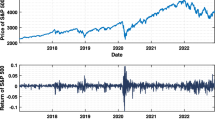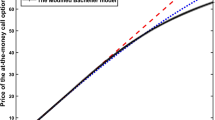Abstract
In this paper, a new concept for some stochastic process called fractional G-Brownian motion (fGBm) is developed and applied to the financial markets. Compared to the standard Brownian motion, fractional Brownian motion and G-Brownian motion, the fGBm can consider the long-range dependence and uncertain volatility simultaneously. Thus it generalizes the concepts of the former three processes, and can be a better alternative in real applications. Driven by the fGBm, a generalized fractional Black–Scholes equation (FBSE) for some European call option and put option is derived with the help of Taylor’s series of fractional order and the theory of absence of arbitrage. Meanwhile, some explicit option pricing formulas for the derived FBSE are also obtained, which generalize the classical Black–Scholes formulas for the prices of European options given by Black and Scholes in 1973.
Similar content being viewed by others
References
Avellaneda, M., Levy, A., & Paras, A. (1995). Pricing and hedging derivative securities in markets with uncertain volatilities. Applied Mathematical Finance, 2 (2), 73–88.
Biagini, F., Hu, Y., Oksendal, B., & Zhang, T. (2008). Stochastic calculus for fractional Brownian motion amd applications. London: Springer.
Björk, T., & Hult, H. (2005). A note on Wick products and the fractional Black–Scholes model. Finance and Stochastics, 9 (2), 197–209.
Black, F., & Scholes, M. (1973). The pricing of options and corporate liabilities. Journal of Political Economy, 81 (3), 659–673.
Cartea, A., & del Castillo-Negrete, D. (2007). Fractional diffusion models of option prices in markets with jumps. Physica A, 374 (2), 749–763.
Cen, Z., Huang, J., Xu, A., & Le, A. (2018). Numerical approximation of a time-fractional Black–Scholes equation. Computers and Mathematics with Applications, 75 (8), 2874–2887.
Chen, W., Du, K., & Qiu, X. (2018). Analytic properties of American option prices under a modified Black–Scholes equation with spatial fractional derivatives. Physica A, 491, 37–44.
Chen, W., Xu, X., & Zhu, S. (2014). Analytically pricing European-style options under the modified Black–Scholes equation with a spatial-fractional derivative. Quarterly of Applied Mathematics, 72 (3), 597–611.
Chen, Z., & Epstein, L. (2002). Ambiguity, risk, and asset returns in continuous time. Econometrica, 70 (4), 1403–1443.
Denis, L., Hu, M., & Peng, S. (2011). Function spaces and capacity related to a sublinear expectation: application to G-Brownian motion paths. Potential Analysis, 34 (2), 139–161.
Denis, L., & Martini, C. (2006). A theoretical framework for the pricing of contingent claims in the presence of model uncertainty. Annals of Applied Probability, 16 (2), 827–852.
Elliott, R. J., & Hoek, J. V. (2003). A general fractional white noise thoery and applications to finance. Mathematical Finance, 13 (2), 301–330.
Epstein, L. G., & Ji, S. (2013). Ambiguous volatility and asset pricing in continuous time. Review of Financial Studies, 26 (7), 1740–1786.
Fama, E. F. (1965). The behavior of stock market prices. Journal of Business, 38 (1), 34–105.
Golbabai, A., & Nikan, O. (2020). A computational method based on the moving least-squares approach for pricing double barrier options in a time-fractional Black–Scholes model. Computational Economics, 55 (1), 119–141.
Golbabai, A., Nikan, O., & Nikazad, T. (2019). Numerical analysis of time fractional Black–Scholes European option pricing model arising in financial market. Applied Mathematics and Computation, 38 (4), 173.
Guo, C., Fang, S., He, Y. (2021). A generalized stochastic process: fractional G-Brownian motion. Under review.
Haq, S., & Hussain, M. (2018). Selection of shape parameter in radial basis functions for solution of time-fractional Black–Scholes models. Applied Mathematics and Computation, 335, 248–263.
Hu, Y., & Øksendal, B. (2003). Fractional white noise calculus and applications to finance. Infinite Dimensional Analysis, Quantum Probability and Related Topics, 6 (1), 1–32.
Jumarie, G. (1993). Stochastic differential equations with fractional Brownian motion input. International Journal of Systems Science, 24 (6), 1113–1132.
Jumarie, G. (2005). On the representation of fractional Brownian motion as an integral with respect to (dt)$\alpha $. Applied Mathematics Letters, 18 (7), 739–748.
Jumarie, G. (2006a). Fractionalization of the complex-valued Brownian motion of order n using Riemann–Liouville derivative. Applications to mathe- matical finance and stochastic mechanics. Chaos, Solitons & Fractals, 28 (5), 1285–1305.
Jumarie, G. (2006b). Modified Riemann–Liouville derivative and fractional Taylor series of nondifferentiable functions further results. Computers and Mathematics with Applications, 51 (9–10), 1367–1376.
Jumarie, G. (2008). Stock exchange fractional dynamics defined as fractional exponential growth driven by (usual) Gaussian white noise. Application to fractional Black–Scholes equations. Insurance: Mathematics and Economics, 42 (1), 271–287.
Jumarie, G. (2010). Derivation and solutions of some fractional Black–Scholes equations in coarse-grained space and time. Application to Merton’s optimal portfolio. Computers & Mathematics with Applications, 59 (3), 1142–1164.
Klebaner, F. C. (2012). Introduction to stochastic calculus with applications. London: Imperial College Press.
Kolmogorov, A. N. (1940). Wienersche spiralen und einige andere interessante kurven im hilbertschen raum. Comptes Rendus de (Doklady) Akademii nauk URSS (N.S.), 26, 115–118.
Liang, J., Wang, J., Zhang, W., Qiu, W., & Ren, F. (2010). Option pricing of a bi-fractional Black–Merton–Scholes model with the Hurst exponent H in $[\frac{1}{2},1]$. Applied Mathematics Letters, 23 (8), 859–863.
Liang, J., Wang, J., Zhang, W., Qiu, W., & Ren, F. (2010). The solutions to a bi-fractional Black–Scholes–Merton differential equation. International Journal of Pure and Applied Mathematics, 58 (1), 99–112.
Lo, A. W., & MacKinlay, A. C. (1988). Stock market prices do not follow random walks: Evidence from a simple specification test. The Review of Financial Studies, 1 (1), 41–66.
Lyons, T. J. (1995). Uncertain volatility and the risk-free synthesis of derivatives. Applied Mathematical Finance, 2 (2), 117–133.
Mandelbrot, B. B., & Van Ness, J. W. (1968). Fractional Brownian motions, fractional noises and applications. SIAM Review, 10 (4), 422–437.
Miller, K. S., & Ross, B. (1993). An introduction to the fractional calculus and fractional differential equations. New York: Wiley.
Necula, C. (2002). Option pricing in a fractional Brownian motion environment. Mathematical Reports, 2 (3), 259–273.
Peng, S. (2007a). G-Brownian motion and dynamic risk measure under volatility uncertainty. (Preprint at arXiv:0711. 2834)
Peng, S. (2011). G-Gaussian processes under sublinear expectations and q-Brownian motion in quantum mechanics. (Preprint at arXiv:1105.1055)
Peng, S. (2005). Nonlinear expectations and nonlinear Markov chains. Chinese Annals of Mathematics, 26B (2), 159–184.
Peng, S. (2007). G-expectation, G-Brownian motion and related stochastic calculus of Itô’s type. In F. E. Benth (Ed.), Stochastic analysis and applications (pp. 541–567). Berlin: Springer.
Peng, S. (2008). Multi-dimensional G-Brownian motion and related stochastic calculus under G-expectation. Stochastic Processes and their Applications, 118 (12), 2223–2253.
Peng, S. (2019). Nonlinear expectations and stochastic calculus under uncertainty. Berlin: Springer.
Podlubny, I. (1999). Fractional differential equations. New York: Academic Press.
Privault, N. (2013). Stochastic finance. An introduction with market examples. Boca Raton: CRC Press.
Rogers, L. C. G. (1997). Arbitrage with fractional Brownian motion. Mathematical Finance, 7 (1), 95–105.
Sottinen, T. (2001). Fractional Brownian motion, random walks and binary market models. Finance and Stochastics, 5 (3), 343–355.
Soumana-Hima, A. (2017). Stochastic differential equations under g- expectation and applications. Rennes: Université Rennes.
Sun, H. G., Zhang, Y., Baleanu, D., Chen, W., & Chen, Y. Q. (2018). A new collection of real world applications of fractional calculus in science and engineering. Communications in Nonlinear Science and Numerical Simulations, 64, 213–231.
Vorbrink, J. (2014). Financial markets with volatility uncertainty. Journal of Mathematical Economics, 53 (2), 64–78.
Wyss, W. (2000). The fractional Black–Scholes equation. Fractional Calculus and Applied Analysis, 3 (1), 51–61.
Acknowledgements
This research was supported by National Natural Science Foundation of China (Nos. 72101061 and 71974038), and Guangdong Basic and Applied Basic Research Foundation (No. 2019A1515011749).
Author information
Authors and Affiliations
Corresponding author
Additional information
Publisher's Note
Springer Nature remains neutral with regard to jurisdictional claims in published maps and institutional affiliations.
Rights and permissions
About this article
Cite this article
Guo, C., Fang, S. & He, Y. Derivation and Application of Some Fractional Black–Scholes Equations Driven by Fractional G-Brownian Motion. Comput Econ 61, 1681–1705 (2023). https://doi.org/10.1007/s10614-022-10263-5
Accepted:
Published:
Issue Date:
DOI: https://doi.org/10.1007/s10614-022-10263-5




